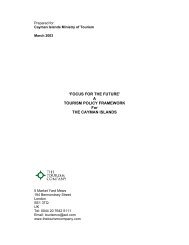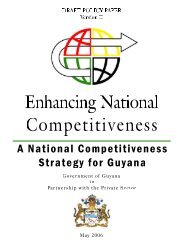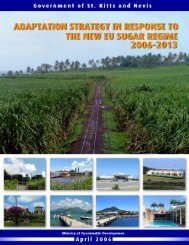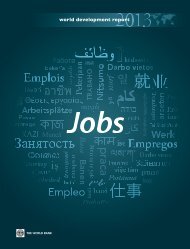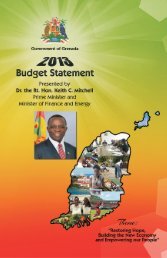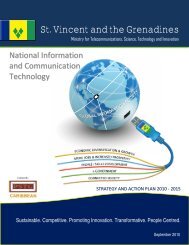Business Removing
Doing Business in 2005 -- Removing Obstacles to Growth
Doing Business in 2005 -- Removing Obstacles to Growth
- No tags were found...
Create successful ePaper yourself
Turn your PDF publications into a flip-book with our unique Google optimized e-Paper software.
44 DOING BUSINESS IN 2005<br />
FIGURE 6.3<br />
High costs to create collateral in Africa<br />
Cost to create and register a collateral agreement<br />
Percentage of income per capita<br />
39 Sub-Saharan Africa<br />
22 Middle East & North Africa<br />
20 Latin America & the Caribbean<br />
7 Europe & Central Asia<br />
6 South Asia<br />
5 OECD high income<br />
3 East Asia & the Pacific<br />
Source: Doing <strong>Business</strong> database.<br />
22 Poor<br />
10 Middle income<br />
5 Rich<br />
main asset, accounts receivable, requires the notification<br />
and consent of all the debtors.<br />
After the type of security and debt is agreed, a lender<br />
wants to check for existing rights to the collateral and<br />
alert others of its priority. The best way is with a collateral<br />
registry. Most countries have some type of registry—for<br />
security over land, vessels, aircraft and intellectual<br />
property. And in most an agreement is binding<br />
over third parties only if it is registered. But only 30 have<br />
registries that allow registration of charges of all types of<br />
movable property, as well as link the registry across regions,<br />
to make it easy to retrieve information.<br />
Creating and registering movable collateral is easy<br />
in many countries. In Botswana, Canada, Kuwait, the<br />
Netherlands, New Zealand, the United Kingdom and the<br />
United States, fees, taxes and stamp duties are negligible,<br />
and registration is complete in 1 or 2 days. But in others,<br />
costs in a standardized case of creating security add up to<br />
50% of income per capita or more (figure 6.3, table 6.2). 5<br />
Most countries register charges within 2 weeks. But<br />
it takes more than a month in Azerbaijan, Ghana, Honduras,<br />
India, Mexico, Nicaragua, Paraguay and South<br />
Africa. In Poland registration takes place in the court,<br />
where a judge must certify the legality of the agreement.<br />
The process can take 6 months. In the meantime, a<br />
fraudulent borrower could pledge the asset to another<br />
creditor. And the main business of courts—resolving<br />
disputes—is held up.<br />
Costs to create collateral are highest in poor countries<br />
and lowest in Asian and OECD countries. Countries<br />
with no registries are cheaper. But the creditors lose<br />
out elsewhere because they have no way of notifying<br />
others of their right to the collateral.<br />
Collateral registration is only part of the story. Laws<br />
on who has priority to the collateral introduce another<br />
set of risks. In India the creditor can lose out to unpaid<br />
taxes, to someone who bought the collateral in good<br />
faith or to judgment creditors. 6 India is not alone. Sixty<br />
countries give priority to a claimant other than the secured<br />
creditor. The uncertainty means higher interest<br />
rates and less credit for borrowers.<br />
In Brazil credit can be secured by movable collateral,<br />
but only at high cost and with a painstakingly specific<br />
description in the loan agreement. If the debtor defaults,<br />
an even bigger obstacle arises. Creditors must file a claim<br />
with the court. Long proceedings ensue before the judge<br />
decides to enforce and orders bailiffs to seize the assets.<br />
After appraisal, a public auction is scheduled and advertised.<br />
The court determines a minimum price. If met,<br />
sale proceeds are deposited in a public agency and distributed<br />
through settlement procedures. Debtors have<br />
unlimited opportunities to drag the process by appeal.<br />
Enforcement takes more than 7 years.<br />
In another 40 countries enforcing collateral requires<br />
the same long court trial as for unsecured debt. Prospects<br />
for recovery are dim. Lenders respond with huge collateral<br />
requirements and high interest rates. In Zambia average<br />
collateral requirements are more than 3 times the<br />
value of the loan and interest rates top 28%. 7 Few can afford<br />
such terms. Compare this with Australia. The creditor<br />
would appoint a receiver and serve notice on the borrower.<br />
The receiver would seize and sell the asset. No<br />
courts are involved, as long as the debtor cooperates. Enforcement<br />
is over in 10 days. In Latvia, even if the debtor<br />
does not cooperate with out-of-court measures, enforce-<br />
TABLE 6.2<br />
The least expensive to create collateral—and the<br />
most<br />
Cost to create and register security, % income per capita<br />
Top 10 Bottom 10<br />
New Zealand 0.02 Egypt, Arab Rep. 52.7<br />
Netherlands 0.03 Jordan 56.3<br />
Canada 0.05 Mali 58.5<br />
Kuwait 0.06 Morocco 62.2<br />
United Kingdom 0.07 Niger 74.6<br />
Puerto Rico 0.09 Benin 80.7<br />
United States 0.14 Togo 83.4<br />
Hong Kong, China 0.18 Cameroon 87.6<br />
Taiwan, China 0.20 Congo, Dem. Rep. 130.0<br />
Albania 0.25 Côte d’Ivoire 155.9<br />
Note: Austria, Cambodia, Germany, Saudi Arabia and Switzerland have no cost but<br />
also no collateral registry.<br />
Source: Doing <strong>Business</strong> database.



